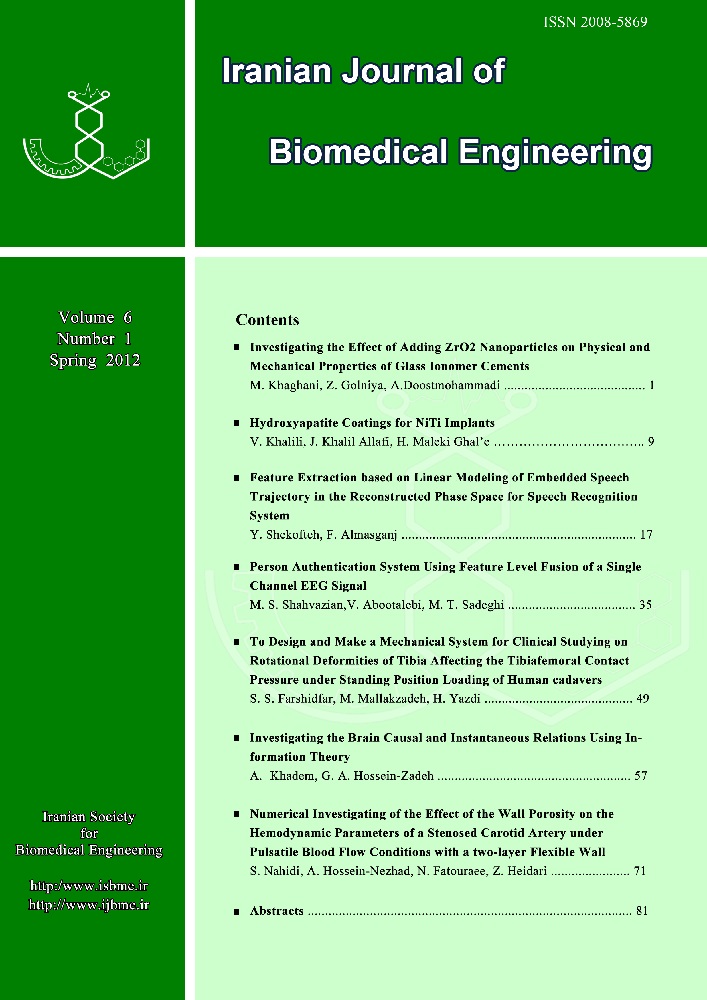[1] W. Donnlley, J.Callaghan, Hydroxyapatite coating in the adult hip; Lippincottraven pub, 1998; 1041-1054.
[2] L. S. Castleman, S. Motzkin, F. P. Alicandri, V. L. Bonawit, J. Biomed, Biocompatibility of Nitinol Alloy as anImplant Material; MATEK. RES, 1976; 10: 695-731.
[3] A.R. Pelton, D. Stockel, T. W. Duerig, Medical Uses of Nitinol; Mater Sci Forum, 2000; 327-328:63-70.
[4] C. Greiner , S. M. Oppenheimer, D. C. Dunand , High strength, low stiffness, porous NiTi with superelastic properties; Acta Biomate, 2005; 1:705–716.
[5] X. Feng Xiao, R. F. Liu, Effect of suspension stability on electrophoretic deposition of hydroxyapatite coatings; Mater Lett, 2006; 60:2627–2632.
[6] M. Javidi, S. Javadpour, M.E. Bahrololoom, J. Ma, Electrophoretic deposition of natural hydroxyapatite on medical grade 316L stainless steel; Mater Sci Eng C, 2008; 28: 1509-1513.
[7] P. Sarker, P. S. Nicholson, Electrophoretic Deposition (EPD): Mechanism, Kinetics, and Application to ceramics; JAm CeramSoc, 1996; 79: 1987-2002.
[8] P.Ducheyn, W.Van Raemdonc, J. C.Heughebaer, M.Heughebaer, Structural analysis of hydroxyapatite coatings on titanium; Biomaterials, 1986; 7: 97-103.
[9] X.Pang, T.Casagrande, I.Zhitomirsky, Electrophoretic deposition of hydroxyapatite–CaSiO3–chitosan composite coatings; J Colloid Interface Sci 2009; 330: 323–239.
[10] K.Grandfield, F.Sun, M.F. Patrick, M.Cheong, I.Zhitomirsky, Electrophoretic deposition of polymer-carbon nanotube–hydroxyapatite composites; Surf Coat Technol, 2009; 203: 1481–1487.
[11] X.Feng-juan, Z.Ying, Y.Li-jiang, Electrophoretic deposition of titanium/silicon-substituted hydroxyapatite composite coating and its interaction with bovine serum albumin; Trans Nonferrous Met Sco China, 2009; 19: 125-130.
[12] Y.Bai, M.Prasad-Neupane, I.Song-Park, M.Ho-Lee, T.Sung-Bae, F.Watari, M.Uo, Electrophoretic deposition of carbon nanotubes–hydroxyapatite nanocomposites on titanium substrate; Mater Sci Eng C, 2010; 30: 1043–1049.
[13] J. C.Huang, Y. J.Ni, Z. C.Wang, Preparation of hydroxyapatite functionally gradient coating on titanium substrateusing a combination of electrophoretic deposition and reaction bonding process; Surf Coat Technol, 2010; 204: 3387–3392.
[14] M.Mihailović, A.Patarić, Z.Gulišija, D.Veljović, D.Janaćković, Electrophoretically deposited nanosized hydroxyapatite coatings on 316lvm stainless steel for orthopaedic implants; Chem Ind Chem Eng Q, 2011; 17: 45−52.
[15] B.Zhang, C. T. Kwok, Hydroxyapatite-anatase-carbon nanotube nanocomposite coatings fabricated by electrophoretic codeposition for biomedical applications; J Mater Sci: Mater Med, 2011; 22: 2249–2259.
[16] M. E. Bahrololoom, M. Javidi, S. Javadpour and J. Ma, Characterisation of natural hydroxyapatite extracted from bovine cortical bone ash; J Ceram Process Res, 2009; 10: 129-138.
[17] F. Sun, K.N. Sask, J.L. Brash, I. Zhitomirsky, Surface modifications of Nitinol for biomedical applications; Colloids Surf B: Biointer, 2008; 67: 132–139.
[18] A. Oyane, H. Kim, T. Furuya, T. Kokubo, T. Miyazaki, T. Nakamura; Preparation and assessment of revised simulated body fluids; Inc J Biomed Mater Res, 2002; 65(A): 188-195.
[19] M. Wei, A. J. Ruys, M. V. Swain, B. K. Milthorpe, C. C. Sorrell, Hydroxyapatite-coated metals: Interfacial reactions during sintering; J Mater Sci: Mater Med, 2005; 16: 101– 106.
[20] C. Ergun, R.H. Doremus, W.A. Lanford, Interface reaction/diffusion in hydroxylapatite-coated SS316L and CoCrMo alloys; Acta Mater, 2004; 52: 4767–4772.
[21] P. Ducheyne, K. E. Healy, The effect of plasma-sprayed calcium phosphate ceramic coatings on the metal ion release from porous titanium and cobalt-chromium alloys; J Biomed Mater Res, 1988; 22: 1137-1163.
[22] I. Zhitomirsky, Electrophoretic deposition of hydroxyapatite; J Mater Sci: Mater Med, 1997; 8: 213- 219.
[23] M. Metikos, A. Kwokal, J. Piljac, The influence of niobium and vanadium on passivity of titanium-bases implants in physiological solution; Biomaterials, 2003; 24: 3765-3775.

